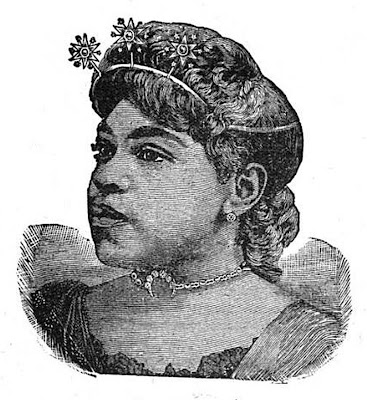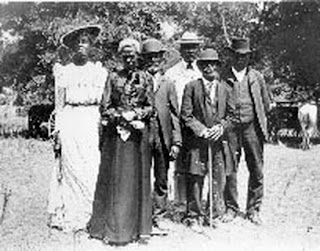HON. JEREMIAH A. BROWN. Legislator—Carpenter and Joiner—Clerk—Deputy Sheriff—Turnkey and Letter-Carrier.
ON. JEREMIAH A. BROWN, or as he is familiarly called "Jere," was the. first child of Thomas A. and Frances J. Brown, Pittsburgh, Allegheny county, Pennsylvania. In that city on the fourteenth of November, 1841, the subject of our sketch first saw the light of day. His younger days were spent in that city where he attended school, having among his classmates such men as the Rev. Benjamin T. Tanner, D. D.,Hon. T. Morris Chester, James T. Bradford of Baltimore, Maryland, and many other distinguished men, who are now prominently before the people.
He continued in the pursuits of knowledge with these until about his thirteenth year, when he accompanied his father as a^steamboatman on our Western rivers. This avocation engaged his attention until his seventeenth year, when he became very much imbued with the importance of the advancement of himself in such a particular as to secure to him the possibilities of a livelihood. To this end he learned a trade, choosing that of a carpenter and joiner. At the close of his seventeenth year he entered the shop of James H. McClelland, Esq., as an apprentice. This gentleman was the foremost builder in that city at the time, and a gentleman known far and wide for his interest in the advancement of the colored people.
Upon his entrance into this shop, it was the immediate signal for a number of the employees quitting work, such was the prejudice existing against a colored boy entering upon any of the trades; but Mr. McClelland promptly filled their places, with the remark: "that that boy will stay in this shop until he learns the trade, if I have to fill it with black mechanics from the South." Thus was the backbone of prejudice broken by this bold stand, and our young man remained and finished his trade with honor to himself, his race, and his friendly employer. After finishing his apprenticeship, his parents decided to remove to Canada West, believing that it would be beneficial to the children, of whofn they had six, to be under a government that did not sanction human slavery.
 | They desired to take their children away from its blighting and withering effects; not as practiced in its enormities, but as sanctioned by the laws of Ohio, which were then known as the "black laws," and against which he has had an opportunity to battle in the Legislature of Ohio. These black laws were very obnoxious to the colored citizens and have constantly provoked unlimited antagonism from them and their ardent white friends. Young Brown accompanied them to Canada and settled near Chatham, Ontario. Upon the inauguration of the Civil War he returned to the United States and located in St. Louis, Missouri, and again returned to steamboating, but from time to time paid visits to his parents. |
January 17, 1864, he was married to Miss Mary A. Wheeler, of Chatham, Ontario, a sister of Hon. Lloyd G. Wheeler, of Chicago Illinois, and the Rev. Robert F. Wheeler, of Hartford, Connecticut. Returning to St. Louis, he remained there a short time and then he decided to settle in the State of Ohio. With that end in view he went there in 1869 or 1870, stopping at Wilberforce, Ohio, to which place his parents had removed for the purpose of educating their youngest children. After prospecting in several cities in the southern part of Ohio, he determined upon Cleveland as the place where he would locate and lay the foundation for a useful and happy life; and here he has remained ever since.
A few years' residence found him an active participant in the political field. His first political position was a bailiff of the probate court of that county; then he was deputy sheriff and turnkey of the county prison for four years, and clerk of the " City Boards of Equalization and Revision." Then he obtained a position in the post office as letter-carrier and remained in the employ of the general government until the fall of 1885, when he secured the nomination on the Republican ticket as representative in the Ohio Legislature from Cuyahoga county, being elected by nearly three thousand majority over the highest competitor on the Democratic ticket—an honor by no means small.
His career has been short, and yet long enough to show that he has made due effort to wipe out those prescriptive laws of the State which we have spoken of above. He made a telling speech on the subject March 10, 1886, a bill having been introduced by the Hon. Benjamin W. Arnett. Said he:
All the colored man desires, Mr. Speaker, is that he be given the same legislation that is accorded to other men. No man can deny that we have proven ourselves other than true, patriotic and honorable citizens. Going back to the early days of the history of our country, where the picture is presented of the black man, in person of Crispus Attacks shedding his blood, the first split in the great American war for freedom, we are forced to stand appalled at that country's ingratitude. When, again, I bring in this galaxy of bright lights, Benjamin Banneker, the great mathematician, and those brave men of my race who fought, bled and died for my country in the War of 1812, Iask you,gentlemen,is such ostracism the reward for that heroism and devotion? But when I contemplate the actions of the American Negro on the battlefield of the South—at the many scenes of carnage in which he was engaged during the late War of the Rebellion—with what heroism he performed deeds of valor, showing and demonstrating his ability even at the cannon's mouth, my very heart bleeds for the foul blot heaped upon the countless thousands of black men, who laid their lives upon their country's altar tor the establishment and the perpetuity of this government. In that Southland my race put on the blue, shouldered their muskets, and to-day their bones lie bleaching on dozens of battlefields, where they were massacred by those who sought to destroy this fair land. What, gentlemen, I ask you, is the reward Ohio gives those of her black sons whose bones are scattered there?
Further on, in reference to these black laws, he says:
Repeal them, and to your ensign will cluster the friendship of my race— redress our grievances with that power delegated to every American citizen. Defeat this bill, and the wrath of the colored voters will bury you beneath their ballots cast by as loyal citizens as the sun of Heaven looks down upon. Repeal them, and in after years when we show our children these obnoxious and pernicious laws, explaining to them the disadvantages we were subjected to, by and under them, we can teach them to love and venerate the memories of those who were instrumental in giving us equal facilities with our more than favored brethren.
Mr. Brown is connected with the Masonic fraternity of Ohio, by whom he is highly honored and respected, as is"readily shown by the numerous positions he has held. For a. number of years he has held, and is at this time holding, the grand secretaryship of the Grand Lodge F. A. A. M. of the Grand Chapter R. A. M.; Grand Recorder of the Grand Commandery of Knights Templars and of the order of High Priesthood; he is also a member of the Carpenters' and Joiners' Brotherhood of America; believing that organization, if good for white men, is equally, if not more, beneficial to the black men. His early education was acquired in the common schools of his native State, with a short course in the Avery College of Allegheny, Pennsylvania.
At that time the facilities and opportunities for acquiring an education were far below what are now in vogue. There were no opportunities for black men other than situations of a menial and degrading character to be obtained; but he, imbued with the firm determination to enter the race of life, succeeded in arriving at a point where he can be called a successful man, and has indeed risen from the carpenter's bench, and a common laborer on a steamboat, to the distinguished position of a lawmaker of the State of Ohio. His religious training was under the A. M. E. Church while a youth, but he is not connected with any denomination now, but attends the Congregational Church, the Sabbath school of which is and has been under the superintendency of his wife for about eight years. In financial affairs he has succeeded moderately, being worth probably five thousand dollars. May his life and success be some encouragement for those who find life hard and labor become unprofitable.
TEXT and IMAGE CREDIT:
Men of mark: eminent, progressive and rising

































